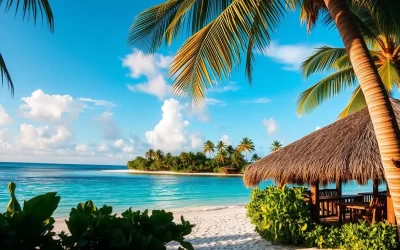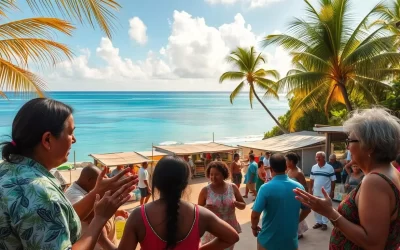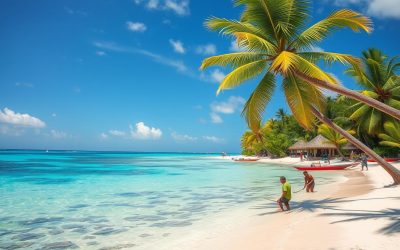✓ Accommodations✓ Flights✓ Rental Cars
Did you know Kiribati is the first country in the world to welcome the New Year? This remote island nation, located in the Central Pacific, is a hidden gem with a fascinating blend of cultures and traditions. Its unique location spans the Gilbert Islands, Line Islands, and more, offering an unforgettable travel experience.
When planning your visit, understanding the official currency is essential. Kiribati uses both the Australian dollar and its own local dollar, making it a unique destination for travelers. This guide will help you navigate currency exchanges, payment options, and local cash practices with ease.
From its rich history, including remnants of WWII, to its vibrant local traditions, Kiribati is a place like no other. Whether you’re exploring its stunning atolls or interacting with its warm and welcoming people, this guide ensures you’re prepared for every step of your journey.
Introduction to Kiribati’s Unique Travel Experience
Escape the ordinary and find yourself in a place where the ocean whispers secrets of a bygone era. This remote island destination offers a travel experience unlike any other, blending untouched natural beauty with a vibrant local culture.
Discovering a Remote Pacific Paradise
Kiribati’s pristine beaches and crystal-clear waters are a testament to its untouched charm. Unlike crowded tourist hotspots, this location invites you to connect with nature on a deeper level. Whether you’re exploring the sea or hiking through lush trails, every moment feels like a discovery.
Choosing the right accommodation is key to making the most of your trip. From cozy guesthouses to beachfront stays, there’s an option for every traveler. Local transfer services ensure you can navigate the islands with ease, though planning ahead is essential for inter-island flights.
Why Kiribati Stands Apart from Typical Island Destinations
What sets this destination apart is its authenticity. Here, you’ll find no cookie-cutter resorts, but instead, a chance to immerse yourself in the local way of life. Savor traditional food, engage with friendly communities, and embrace the slower pace of island time.
As you explore, you’ll notice how the sea and land intertwine to create a unique experience. From fishing with locals to learning about ancient traditions, every day offers something new. This is a place where you can truly disconnect and reconnect with what matters most.
“Kiribati is not just a destination; it’s a journey into the heart of the Pacific.”
Later sections will dive deeper into essential tips for navigating this remarkable location. For now, let the untouched beauty and warm hospitality of Kiribati inspire your next adventure.
Uncovering Kiribati’s Culture, Geography, and Economy
Step into a world where tradition meets the tides of the Central Pacific. This remote island group offers a glimpse into a way of life shaped by the sea, the land, and the resilience of its people. From the Gilbert Islands to the Line Islands, each atoll tells a story of survival, unity, and cultural pride.
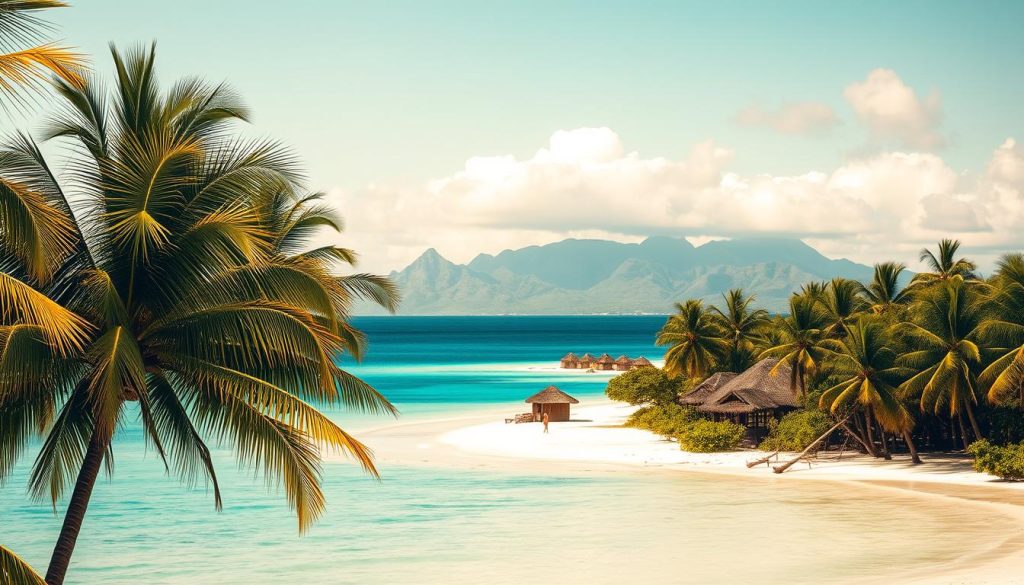
A Glimpse into Island Life and Traditions
Life on these low-lying coral atolls is deeply connected to the ocean. Fishing, weaving, and storytelling are central to the local way of life. Traditional meeting houses, known as maneabas, serve as hubs for community gatherings and cultural events.
Despite modern challenges, the people of this region have preserved their traditions. From preparing food like fresh seafood and coconut-based dishes to exchanging goods using cash, daily life reflects a blend of old and new.
Understanding the Central Pacific Setting
The Central Pacific location has shaped the history and economy of this country. The Gilbert Islands and Line Islands are not just geographical markers but symbols of identity. Rising sea levels, however, pose a significant threat to this fragile ecosystem.
Visitors to this island group will find limited accommodation and amenities, but the warmth of the local community more than compensates. Understanding the history and geography is essential for a meaningful experience.
“The ocean is our lifeblood, and the land our heritage. Together, they define who we are.”
From the remnants of WWII battles to the challenges of climate change, this region is a testament to resilience. Whether you’re exploring the Gilbert Islands or the Line Islands, you’ll discover a place where culture and nature are inseparable.
Kiribati: Ultimate Travelers Guide to Currencies & Payments
Navigating the financial landscape of a remote island destination can be both exciting and challenging. This travel guide focuses on helping you manage your money efficiently during your stay. Understanding the official currency and payment options is essential for a stress-free experience.
In this country, the Australian dollar is the legal tender, alongside the local dollar. Both currencies are accepted interchangeably, making it easier for travelers. However, cash remains the primary payment method, especially in smaller shops and local markets.
When planning your trip, consider the limited availability of ATMs and digital payment options. While some hotels accept Visa and MasterCard, it’s wise to carry enough cash for daily expenses. Timing your transfers and understanding exchange rates can save you money and hassle.
Here’s a quick overview of the currency system:
| Currency | Acceptance | Tips |
|---|---|---|
| Australian Dollar (AUD) | Widely accepted | Carry small denominations |
| Local Dollar | Used interchangeably | Check exchange rates |
This destination offers a unique blend of traditional and modern payment methods. While digital options are emerging, planning ahead ensures you’re prepared for any situation. Later sections will dive deeper into smart money management strategies to enhance your experience.
“Understanding the currency system is the first step to a seamless journey.”
Whether you’re exploring the islands or enjoying the local culture, this guide will help you navigate the financial aspects of your trip with confidence.
Understanding Kiribati’s Currency Landscape
Understanding the financial system of a remote island can make your trip smoother and more enjoyable. This destination operates on a dual-currency system, using both the Australian dollar and the local dollar. Both currencies are accepted interchangeably, making it easier for travelers to manage their expenses.
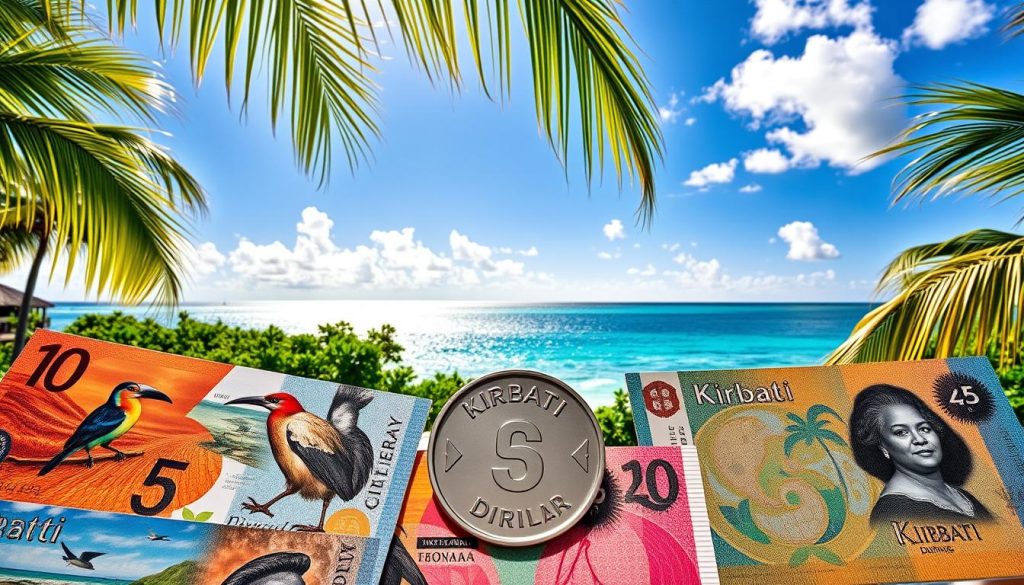
Australian Dollar, Kiribati Dollar, and Their Equivalence
The Australian dollar is the official currency here, but the local dollar holds equal value. This means you can use either for purchases, though carrying smaller denominations is advisable for convenience. The equivalence simplifies transactions, especially in local markets and smaller shops.
Exchange rates are typically stable, but it’s wise to check the current rate before your visit. This ensures you get the best value for your money. Most service providers, including hotels and restaurants, accept both currencies without issue.
Exchange Rates and Cash vs. Digital Payments
While cash remains the primary payment method, digital options are slowly emerging. ATMs are limited, so plan your transfers and withdrawals ahead of time. Some hotels and larger businesses accept credit cards, but smaller vendors often prefer cash.
Here’s a quick comparison of payment methods:
- Cash: Widely accepted, especially in rural areas.
- Digital Payments: Limited but growing, with some hotels accepting Visa and MasterCard.
Managing your money here is straightforward with the right preparation. Keep track of fluctuating rates and fees to avoid unnecessary expenses. Whether you’re exploring the islands or enjoying the local culture, understanding the currency system ensures a seamless experience.
“Planning your finances ahead of time is the key to a stress-free journey.”
In the next section, we’ll dive into smart payment strategies to help you make the most of your travel budget.
Smart Payment Strategies and Money Management
Managing your money wisely is key to enjoying a stress-free trip to this unique destination. With limited cash options and fluctuating rates, planning ahead ensures you stay within budget and avoid unnecessary hassles. Here’s how to make the most of your travel funds while staying secure.
Travel Budgeting and Managing Expenses
Start by creating a daily budget that covers essentials like food, accommodation, and local activities. Keep a mix of cash and accessible funds to handle unexpected costs. For example, allocate a specific amount for meals and souvenirs, and track your spending to stay on track.
When booking hotels or services, look for transparent payment options. Some providers may offer discounts for upfront payments, saving you money in the long run. Always confirm cancellation policies to avoid losing funds if plans change.
Tips for Secure Transactions and Currency Exchange
Carrying cash is essential, especially in rural areas where digital payments are rare. However, use secure transfer services for larger amounts to minimize risks. Keep an eye on exchange rates and plan transfers during favorable times to maximize your funds.
For added security, avoid using public Wi-Fi for financial transactions. Instead, rely on trusted services or apps for digital payments. When withdrawing cash, choose ATMs in well-lit, secure locations and notify your bank of your travel plans to prevent card blocks.
| Payment Method | Pros | Cons |
|---|---|---|
| Cash | Widely accepted, no fees | Risk of theft, limited availability |
| Digital Transfers | Secure, convenient | Limited acceptance, potential fees |
By following these strategies, you can manage your money with confidence and focus on enjoying your experience. Whether you’re exploring the islands or relaxing at your hotel, smart planning ensures a seamless journey.
“A well-planned budget is the foundation of a worry-free adventure.”
Navigating Accommodation and Transportation Costs
Planning your stay in a remote destination requires careful consideration of lodging and transport. Whether you’re looking for a cozy guesthouse or a comfortable hotel, understanding your options helps you make the most of your travel budget. Similarly, navigating inter-island transfers and flight expenses ensures a seamless experience.
Comparing Hotel Options and Guesthouses
In this country, you’ll find a range of accommodation choices. Budget-friendly guesthouses offer a chance to connect with the local community, while hotels provide added comfort and amenities. Here’s a quick comparison:
- Guesthouses: Affordable, often family-run, and ideal for immersive experiences.
- Hotels: More expensive but offer better facilities and services.
When booking, consider the rates and services included. Some hotels may charge additional fees, so read the fine print. Timing your reservation can also save you money, especially during peak seasons.
Handling Inter-Island Transfers and Flight Expenses
Moving between islands is a unique part of your travel experience. Inter-island flights are the most common transfer method, but they can be costly. Booking in advance often secures better rates, and comparing options helps you find the best deal.
Here are some tips to manage flight costs:
- Book early to avoid last-minute price hikes.
- Use cash or secure payment methods for transactions.
- Check for discounts or promotions from local airlines.
Remember, inter-island transfers require planning. Limited schedules and availability mean you should organize your itinerary ahead of time.
“Smart planning ensures you enjoy every moment without breaking the bank.”
By balancing comfort and cost, you can make the most of your stay in this unique destination. Whether you’re exploring the islands or relaxing at your hotel, these tips will help you navigate accommodation and transportation with ease.
Exploring Outdoor Adventures and Island Attractions
Discover the untouched beauty of Kiribati’s outdoor wonders, where adventure meets serenity. This remote destination offers a variety of activities that cater to every traveler’s interests. From sun-kissed beaches to cultural landmarks, there’s something for everyone to enjoy.
Sun-Kissed Beaches and Water Activities
Kiribati’s pristine beaches and crystal-clear seas are a haven for water enthusiasts. Snorkeling and diving reveal vibrant coral reefs teeming with marine life. The calm waters during the dry season, with temperatures around 26°C to 30°C, make it ideal for these activities.
For those seeking thrills, kitesurfing is a popular option from November to March. The locals also offer guided fishing trips, where you can learn traditional techniques and enjoy fresh food prepared with your catch.
Hiking Trails and Cultural Landmarks
Beyond the sea, Kiribati’s lush trails invite you to explore its natural beauty. Hiking through the islands offers breathtaking views and a chance to connect with nature. Along the way, you’ll encounter cultural landmarks that tell the history of this unique destination.
Visit the Betio War Memorial to learn about WWII history, or explore the National Museum in Tarawa for insights into the local way of life. These sites provide a deeper understanding of the groups that have shaped Kiribati over time.
| Activity | Best Time | Tips |
|---|---|---|
| Snorkeling | Dry Season (May-Oct) | Bring reef-safe sunscreen |
| Kitesurfing | Nov-Mar | Check wind conditions |
| Hiking | Early Morning | Wear comfortable shoes |
Whether you’re exploring the islands by day or stargazing at night, Kiribati offers an unforgettable experience. Plan your day to make the most of the outdoor adventures and immerse yourself in the local culture.
“Kiribati’s natural beauty is a reminder of the world’s untouched wonders.”
Delighting in Local Cuisine and Dining Experiences
Exploring the flavors of Kiribati’s cuisine is a journey into the heart of its islands. The food here is a reflection of the local culture, with seafood and traditional dishes taking center stage. Whether you’re dining at a hotel or a roadside shop, every meal offers a taste of the islands’ rich heritage.
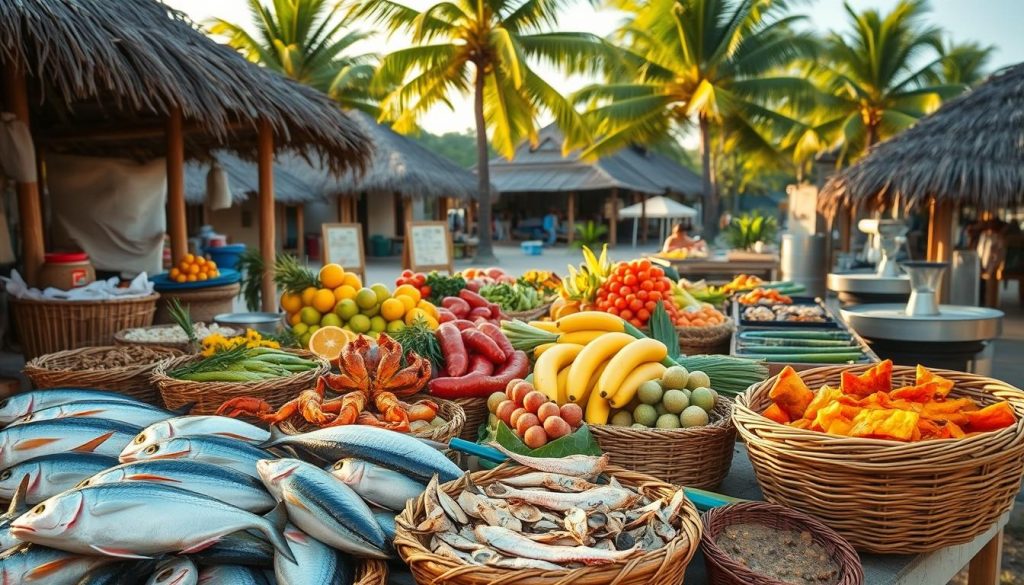
Savoring Seafood and Traditional Dishes
Seafood is a staple in Kiribati, thanks to its abundant marine resources. Freshly caught fish, crab, and shellfish are often prepared with coconut milk and served with taro or breadfruit. These dishes are not just meals but a celebration of the local way of life.
Traditional recipes have been passed down through generations, preserving the history and culture of the country. When you visit, try dishes like te bua (grilled fish) or te kabubu (coconut crab stew). These flavors are a testament to the variety and richness of Kiribati’s culinary scene.
Local Eateries vs. International Restaurants
Local eateries offer an authentic experience, with simple settings and affordable prices. These spots are perfect for trying traditional food and interacting with the local community. In contrast, international restaurants, often found in hotels, provide a more familiar menu but at higher prices.
Here’s a quick comparison:
- Local Eateries: Affordable, authentic experience, and a chance to connect with locals.
- International Restaurants: Higher prices, familiar options, and added amenities.
Planning Your Trip: Visa, Safety, and Travel Tips
Planning your trip to this remote island destination requires attention to detail and preparation. From securing the right travel documents to staying safe during your stay, these tips will help you navigate your journey with confidence.
Visa Requirements and Essential Travel Documents
Before your arrival, ensure you have the necessary visa. Most visitors need to apply in advance, so check the latest requirements for your country. Keep copies of your passport, visa, and insurance documents in a safe place, and leave a set with someone at home.
For inter-island flights, confirm schedules early to avoid delays. Limited services mean planning ahead is crucial. If you’re renting a car, an International Driving Permit may be required, so prepare accordingly.
Health Considerations and Safety Precautions
Health safety is a priority. Ensure your routine vaccinations are up to date, and consider additional precautions for mosquito-borne diseases. Avoid swimming in polluted areas, and always use safety equipment for boating trips.
When it comes to cash, carry small denominations and avoid showing large sums in public. ATMs are limited, so plan your withdrawals during the day. Keep valuables secure, and use trusted services for transfers.
| Safety Tip | Details |
|---|---|
| Valuables | Leave spare cash and important documents in a secure place. |
| Transport | Arrange for pick-up or drop-off close to your hotel entrance. |
| Health | Stay updated on vaccinations and avoid risky activities. |
“Preparation is the key to a smooth and enjoyable journey.”
By following these guidelines, you can focus on enjoying your experience in this unique destination. Whether you’re exploring the islands or relaxing at your accommodation, careful planning ensures a memorable trip.
Enhancing Your Central Pacific Journey with Local Insights
Immerse yourself in the heart of the Central Pacific by connecting with the warm and welcoming I-Kiribati community. Engaging with locals is not just a part of your travel—it’s the key to unlocking the true essence of this unique destination.
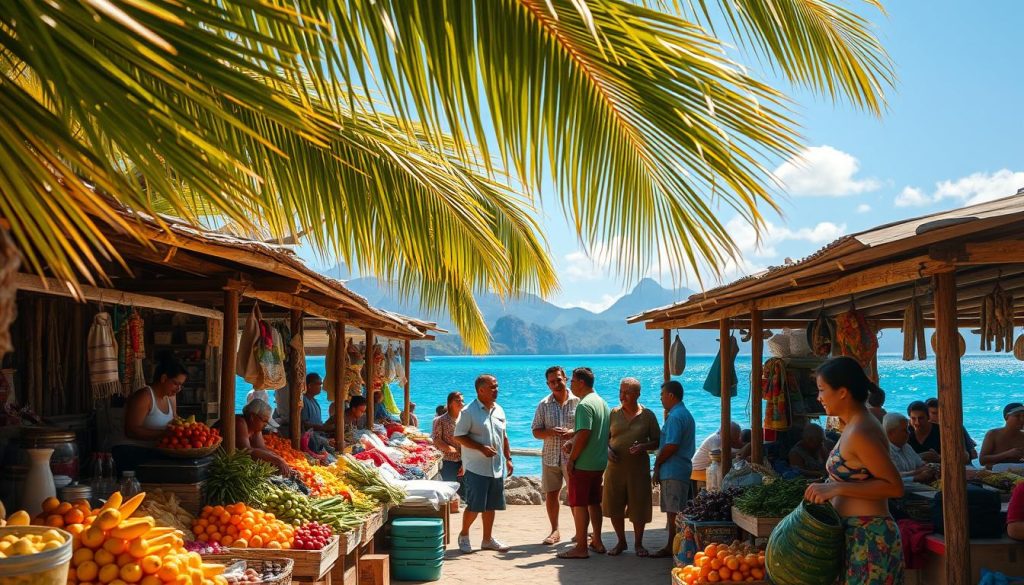
Interacting with the Friendly I-Kiribati Community
The I-Kiribati people are known for their hospitality and openness. Whether you’re attending a community event or visiting a local market, take the time to chat and learn about their way of life. These interactions often lead to personal stories that add depth to your experience.
One of the best ways to connect is through shared meals. Traditional dishes like grilled fish or coconut crab stew are not just food—they’re a window into the country’s culture. Don’t hesitate to ask questions or join in the preparation. It’s these moments that make your journey unforgettable.
Exploring Local Services and Hidden Gems
From local guides to family-run guesthouses, the services here are designed to make you feel at home. Supporting these businesses not only enhances your travel but also contributes to the community. Use cash when shopping at local markets to ensure your spending benefits the island economy.
For a deeper understanding of the Central Pacific identity, visit cultural landmarks or attend traditional meetings. These experiences offer insights into the group’s history and values, enriching your experience.
“The warmth of the I-Kiribati people turns a trip into a journey of the heart.”
Whether you’re exploring during the day or enjoying nighttime activities, the locals are your best guides. Their insights can lead you to hidden gems and unforgettable moments. By embracing these connections, you’ll leave with more than memories—you’ll take home a piece of the Central Pacific spirit.
Conclusion
Your journey to this remote Pacific destination is more than just a trip—it’s an adventure into a world of unique traditions and natural beauty. Understanding the dual-currency system, with the Australian dollar and local dollar, ensures smooth transactions during your stay. Carry cash for smaller shops and markets, as digital options are limited.
Budgeting wisely and choosing the right accommodation can enhance your experience. From cozy guesthouses to comfortable hotels, there’s an option for every traveler. Inter-island transfers require planning, so book flights in advance to avoid last-minute hassles.
Immerse yourself in the local culture by engaging with the friendly community. Savor traditional dishes, explore cultural landmarks, and learn about the history that shapes this unique island group. These interactions will enrich your travel and create lasting memories.
With thoughtful planning and a flexible mindset, you’ll navigate the challenges and embrace the adventure. This guide equips you with the knowledge to make the most of your visit. So pack your bags, prepare for the unexpected, and get ready to explore this remarkable destination to its fullest.
The above is subject to change.
Check back often to TRAVEL.COM for the latest travel tips and deals.



